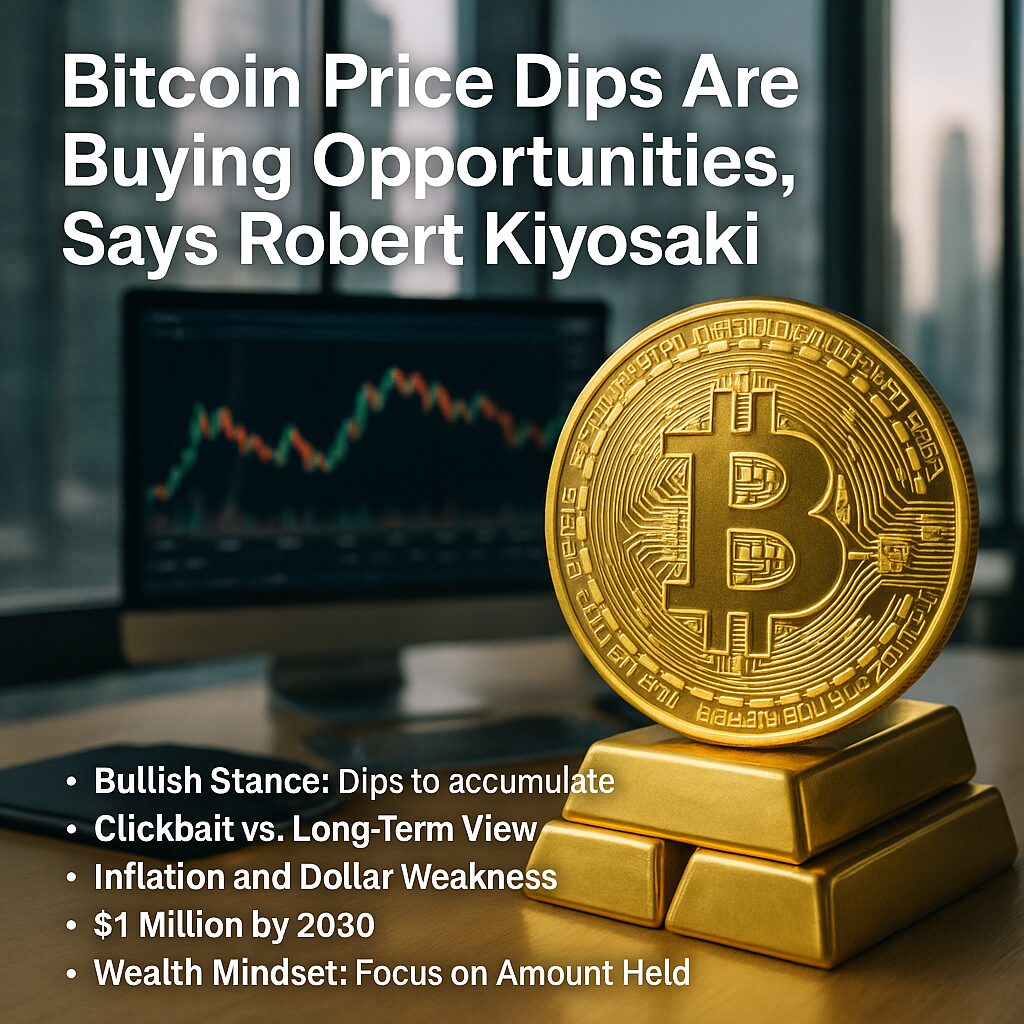
Main Points:
- Kiyosaki’s Bullish Stance: The “Rich Dad, Poor Dad” author remains optimistic on Bitcoin and seeks dips to accumulate.
- Clickbait vs. Long-Term View: Negative price forecasts labeled “clickbait losers” aiming to scare speculators.
- Inflation and Dollar Weakness: Ongoing U.S. inflation and a weakening dollar underpin demand for Bitcoin, gold, and silver.
- $1 Million by 2030: Kiyosaki reiterates his bold prediction that Bitcoin will reach $1 million, emphasizing accumulation over timing.
- Wealth Mindset: “Poor focus on price, rich focus on amount held” – shift attention from volatility to portfolio size.
- Practical Takeaway: Investors should view corrections as entry points and maintain a long-term, accumulation-oriented strategy.
1. Kiyosaki’s Bullish Stance on Bitcoin
Robert Kiyosaki, famed author of Rich Dad, Poor Dad, took to X (formerly Twitter) on July 5, 2025, to reaffirm his enduring optimism on Bitcoin (BTC). While chatter mounts around potential crashes, Kiyosaki dismisses these warnings as scare tactics meant to intimidate retail speculators. Instead of fearing a drop, he hopes for one—so he can buy more at discounted prices. This contrarian approach captures the essence of “buy the dip,” a strategy widely endorsed in crypto circles.
“I want Bitcoin to crash—so I can buy more,” Kiyosaki posted, branding bearish articles and ads as the work of “clickbait losers.”
By reframing a crash as an opportunity rather than a calamity, Kiyosaki underscores a mindset shift crucial for long-term investors: corrections are not failures but invitations to accumulate more of a scarce asset.
2. Clickbait Predictions vs. Long-Term Perspective
The term clickbait refers to sensationalized headlines or ads designed to lure clicks, often exaggerating or misrepresenting content. Kiyosaki accuses those forecasting imminent Bitcoin meltdowns of exploiting this tactic. Such bearish banner ads and articles, he argues, prey on traders’ fear of missing out (FOMO), provoking emotional reactions rather than rational decisions.
Rather than capitulating to daily price swings, investors should adopt a long-term perspective, focusing on fundamentals like adoption rates, on-chain metrics, and institutional interest. This view aligns with that of many seasoned crypto analysts who believe that short-term volatility cannot derail the asset’s multi-year trajectory.
3. Inflation, Dollar Weakness, and Safe-Haven Demand
Concerns over persistent inflation and the gradual weakening of the U.S. dollar have driven renewed interest in alternative stores of value. Since mid-2022, the Federal Reserve’s rate-hiking cycle has slowed, yet inflation remains above target. At the same time, political and fiscal uncertainties have chipped away at dollar confidence.
- Inflation Hedge: Bitcoin’s capped supply of 21 million coins positions it as a deflationary counterweight to fiat.
- Dollar Index: The U.S. Dollar Index (DXY) has slipped from multi-year highs, fueling demand for non-correlated assets.
- Parallel to Gold/Silver: Kiyosaki frequently advocates gold and silver alongside Bitcoin, viewing all three as complementary hedges.
As traditional financial institutions integrate crypto services, the network effect strengthens, bolstering Bitcoin’s role as a digital safe-haven.
4. Forecasting $1 Million by 2030
On June 19, 2025, Kiyosaki doubled down on his bold forecast that Bitcoin will hit $1 million by 2030. At the time, BTC traded around $108,000, making the target roughly 9.3× higher within five years. Such a prediction relies on continued institutional adoption, regulatory clarity, and macroeconomic conditions that favor alternative assets.
- Assumed CAGR: Achieving $1 million requires a compound annual growth rate (CAGR) of approximately 50 percent from mid-2025 levels.
- Comparison to Tech Stocks: Historically, high-growth tech equities have delivered similar returns over shorter windows, providing context to Bitcoin’s potential.
- Risk Factors: Regulatory setbacks, market crashes, or competition from central bank digital currencies (CBDCs) could delay or temper growth.
However, Kiyosaki argues that even if volatile, Bitcoin’s upside dwarfs traditional assets, making dips all the more attractive for accumulation.
5. The Mindset: Focus on Quantity, Not Price
Building lasting wealth in crypto, according to Kiyosaki, requires shifting from a price-centric to a quantity-centric mindset:
“Poor people focus on price; rich people focus on amount held.”
By tracking coin holdings rather than obsessing over dollar value, investors can avoid emotional trading and concentrate on growing their stake. This principle resonates with dollar-cost averaging (DCA) strategies, where investors buy fixed amounts at regular intervals regardless of price, smoothing entry points over market cycles.
6. Practical Takeaways for Crypto Investors
For those seeking new crypto assets, revenue streams, or practical blockchain applications, Kiyosaki’s insights translate into actionable steps:
- Prepare for Dips: Keep fiat reserves ready to deploy during pullbacks.
- Adopt DCA: Automate periodic purchases to neutralize timing risk.
- Diversify Across Safe Havens: Combine Bitcoin with gold and silver for a balanced hedge.
- Monitor Macro Trends: Watch inflation data, Fed announcements, and dollar strength.
- Focus on Fundamentals: Evaluate network activity, institutional flows, and regulatory developments.
By viewing corrections as buying windows and maintaining discipline, investors can potentially amplify gains while mitigating emotional decision-making.
Conclusion
Robert Kiyosaki’s bullish outlook on Bitcoin, reinforced by his dismissal of crash prophecies as mere clickbait, offers a clarion call for long-term accumulation. Against a backdrop of persistent inflation and a weakening U.S. dollar, Bitcoin’s capped supply and growing institutional embrace position it as a cornerstone of modern wealth preservation. Whether or not it reaches $1 million by 2030, adopting a mindset that prioritizes quantity over price and uses market dips as opportunities to buy will serve investors well. For those exploring new crypto assets or practical blockchain use cases, this disciplined, macro-aware approach can help navigate volatility and build lasting portfolios.

